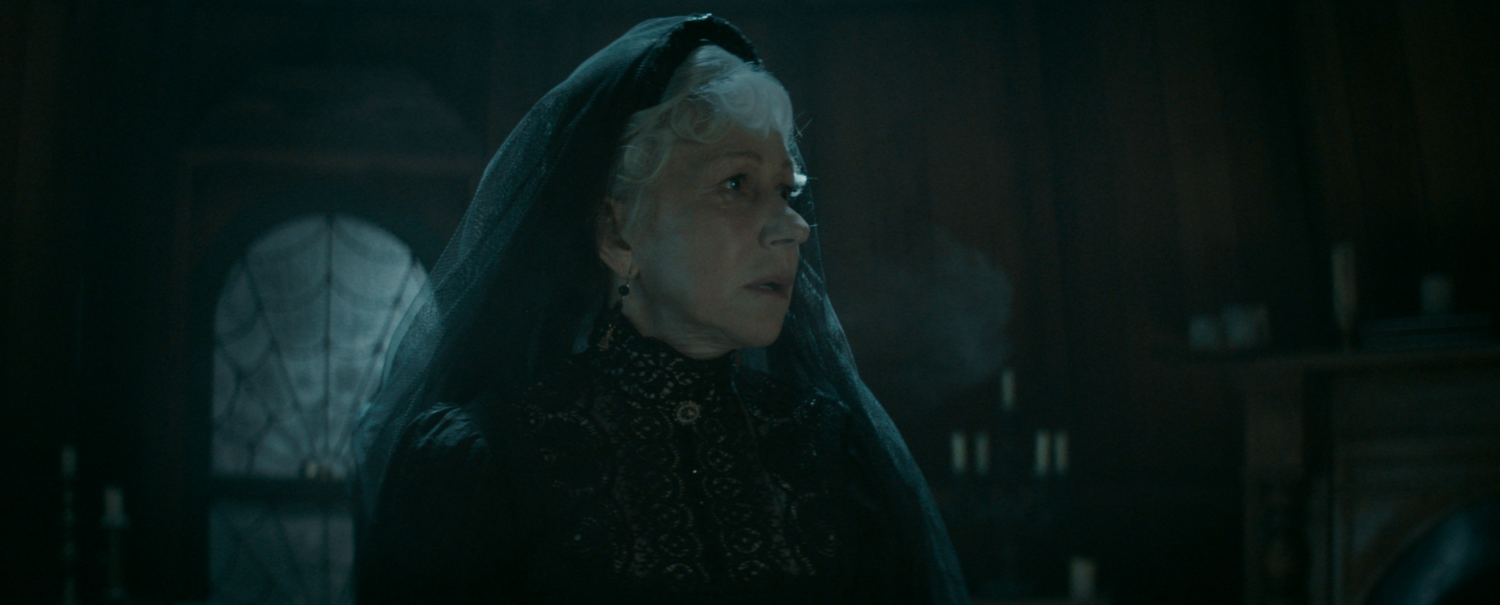Based on true events, Blacklab Entertainments’ Winchester follows eccentric firearm heiress Sarah Winchester (Helen Mirren) as she is haunted by the souls of people killed by the Winchester repeating rifle.
Cutting Edge served as the sole VFX and post production facility for the film, with contributions including full post services and set extension sequences of the 1906 version of the Winchester mansion, sequences for paranormal activity, a foreboding levitation scene with rifles and earthquake simulations.
Delivering 183 final VFX shots, Cutting Edge VFX Supervisor Rangi Sutton joined the Winchester production team onset to closely match the design of the facade, to the house as it still stands in San Jose, USA. With the exception of changing the paint colour to be more historically correct, the closely framed drama was filmed around the facade requiring no VFX enhancements. Whenever the shots were wider, such as establishing shots and tilt-ups, the vast size of the mansion needed to be represented.
VFX Supervisor Rangi Sutton explained: “The mansion was to be seen from all angles, with moving cameras, different lighting, day and night, and it isn’t even the same colour as the house currently is. While we had a great resource as the mansion still stands, this clearly needed to be a 3D build”.
To achieve the 3D build, Rangi worked with a local San Jose drone team to capture over 4000 images of the mansions exterior from hand held cameras and drones. Back in Brisbane, Senior Cutting Edge 3D Artist Robert Kelly compiled the drone photographs into the photogrammetry package Agisoft PhotoScan to create the CG base model of the estate. This gave the team a model to start placing into shots and aligning with the facade.

Credit: Courtesy of Cutting Edge
With core model components ready, the VFX shots started placing the 3D extensions into the camera matched shots. The photogrammetry was an excellent guide to how things should be but was too soft – especially in the details for the distinctive fish-scale wall tiling – and the house was the wrong colour for the period. Section by section our artists replaced the photogrammetry with modelled sections. This was a combination of Maya for the broader architecture, and Houdini to add the procedural shingles and repeating features.

Credit: Courtesy of Cutting Edge
While onset in San Jose, historian Janan Boehme revealed the deconstructed remains of the seven-story tower, that stood prior to the 1906 earthquake. When the tower came down, it wasn’t destroyed – instead, it was stored in pieces. By using measurements and photographs of all these pieces, together with two historical photographs of the tower, an accurate 3D reconstruction was made.

Credit: Courtesy of Cutting Edge
“The Winchester mansion extensions were the result of many VFX disciplines, especially modelling, lighting, compositing and digital matte painting. The introduction of drone-based photogrammetry to the mix meant we quickly got our fundamentals of the work locked in and saved huge amounts of time on set surveys and modelling”, explained Rangi.
Amongst the on-set debris from the earthquake, the climactic scene required our VFX artists to generate a paranormal encounter featuring a standoff between the main characters and a room full of eerily levitating Winchester rifles. Having fallen from their glass display cases, the rifles are surrounded by glass and plaster and covered in dust particles.
Hundreds of photographs were taken of the rifles available on the stage shoot. Senior Asset Artist John Chen used them as a reference to build digital replications of these rifles, adding geometric and textural detail to the point we could have them in the same frame as their practically filmed versions.
The practical on-stage armoury had 50 rifles of which Cutting Edge photographed individually. To build that much variation into the levitating swarm, the 3D artists, lead by Senior 3D Artist Chelsea Shannon, turned to procedural – or programmed – textures. This produced unique wood grain patterns and colours per rifle. The dust splattered over the rifles was handled with a mixture of photographic textures of dust splatters, and procedural shaders to place them in random patterns around the rifles.

Credit: Courtesy of Cutting Edge
“We knew the rifles had to be photorealistic, while being naturally unique and also art directable. This was clearly a scene for Houdini, which gave us hand animated options for key rifles, but also very controllable motion for the swarms of rifles and debris. Every element needed to be tuneable, such as the rate of spin of the pieces of glass versus the amount they would drift through the air”, explained Rangi.
Cutting Edge additionally provided Winchester with clean-up shots, CG axe and ghostly eye VFX, in addition to full picture post & sound including, online, grade and deliverables.
Watch the trailer here:
